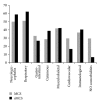Xenobiotic sensor- and metabolism-related gene variants in environmental sensitivity-related illnesses: a survey on the Italian population
- PMID: 23936614
- PMCID: PMC3725911
- DOI: 10.1155/2013/831969
Xenobiotic sensor- and metabolism-related gene variants in environmental sensitivity-related illnesses: a survey on the Italian population
Abstract
In the environmental sensitivity-related illnesses (SRIs), multiple chemical sensitivity (MCS), chronic fatigue syndrome (FCS), and fibromyalgia (FM), the search for genetic polymorphisms of phase I/II xenobiotic-metabolizing enzymes as suitable diagnostic biomarkers produced so far inconclusive results, due to patient heterogeneity, geographic/ethnic differences in genetic backgrounds, and different methodological approaches. Here, we compared the frequency of gene polymorphisms of selected cytochrome P450 (CYP) metabolizing enzymes and, for the first time, the frequency of the xenobiotic sensor Aryl hydrocarbon receptor (AHR) in the three cohorts of 156 diagnosed MCS, 94 suspected MCS, and 80 FM/FCS patients versus 113 healthy controls. We found significantly higher frequency of polymorphisms CYP2C9∗2, CYP2C9∗3, CYP2C19∗2, CYP2D6∗4 and CYP2D6∗41 in patients compared with controls. This confirms that these genetic variants represent a genetic risk factor for SRI. Moreover, the compound heterozygosity for CYP2C9∗2 and ∗3 variants was useful to discriminate between either MCS or FM/CFS versus SMCS, while the PM ∗41/∗41 genotype discriminated between MCS and either SMCS or FM/CFS. The compound heterozygosity for CYP2C9 ∗1/∗3 and CYP2D6 ∗1/∗4 differentiated MCS and SMCS cases from FM/CFS ones. Interestingly, despite the distribution of the AHR Arg554Lys variant did not result significantly different between SRI cases and controls, it resulted useful for the discrimination between MCS and SMCS cases when considered within haplotypes in combination with CYP2C19 ∗1/∗2 and CYP2D6 ∗1/∗4. Results allowed us to propose the genotyping for these specific CYP variants, together with the AHR Arg554Lys variant, as reliable, cost-effective genetic parameters to be included in the still undefined biomarkers' panel for laboratory diagnosis of the main types of environmental-borne SRI.
Figures

Similar articles
-
Allele and genotype frequencies of CYP2C9, CYP2C19 and CYP2D6 in an Italian population.Pharmacol Res. 2004 Aug;50(2):195-200. doi: 10.1016/j.phrs.2004.01.004. Pharmacol Res. 2004. PMID: 15177309
-
Genetic polymorphisms of drug-metabolizing enzymes CYP2D6, CYP2C9, CYP2C19 and CYP3A5 in the Greek population.Fundam Clin Pharmacol. 2007 Aug;21(4):419-26. doi: 10.1111/j.1472-8206.2007.00510.x. Fundam Clin Pharmacol. 2007. PMID: 17635181
-
Polymorphisms of drug-metabolizing enzymes CYP2C9, CYP2C19, CYP2D6, CYP1A1, NAT2 and of P-glycoprotein in a Russian population.Eur J Clin Pharmacol. 2003 Aug;59(4):303-12. doi: 10.1007/s00228-003-0606-2. Epub 2003 Jul 15. Eur J Clin Pharmacol. 2003. PMID: 12879168
-
Impact of genetic polymorphisms in CYP2C9 and CYP2C19 on the pharmacokinetics of clinically used drugs.Drug Metab Pharmacokinet. 2013;28(1):28-37. doi: 10.2133/dmpk.dmpk-12-rv-085. Epub 2012 Nov 20. Drug Metab Pharmacokinet. 2013. PMID: 23165865 Review.
-
Major CYP450 Polymorphism among Saudi Patients.Drug Metab Lett. 2021;14(1):17-24. doi: 10.2174/1872312814666200722122232. Drug Metab Lett. 2021. PMID: 32703145
Cited by
-
A case report of idiopathic environmental intolerance: A controversial and current issue.Clin Case Rep. 2019 Nov 26;8(1):79-85. doi: 10.1002/ccr3.2535. eCollection 2020 Jan. Clin Case Rep. 2019. PMID: 31998492 Free PMC article.
-
Role of polymorphisms of inducible nitric oxide synthase and endothelial nitric oxide synthase in idiopathic environmental intolerances.Mediators Inflamm. 2015;2015:245308. doi: 10.1155/2015/245308. Epub 2015 Mar 24. Mediators Inflamm. 2015. PMID: 25878398 Free PMC article.
-
Association of radiation risk in the second and third generations with polymorphisms in the genes CYP1A1, CYP2E1, GSTP1 and changes in the thyroid.Mol Med. 2019 Nov 14;25(1):48. doi: 10.1186/s10020-019-0117-y. Mol Med. 2019. PMID: 31726965 Free PMC article.
-
The SNP rs2298383 Reduces ADORA2A Gene Transcription and Positively Associates with Cytokine Production by Peripheral Blood Mononuclear Cells in Patients with Multiple Chemical Sensitivity.Int J Mol Sci. 2020 Mar 9;21(5):1858. doi: 10.3390/ijms21051858. Int J Mol Sci. 2020. PMID: 32182774 Free PMC article.
-
Redox Control of Multidrug Resistance and Its Possible Modulation by Antioxidants.Oxid Med Cell Longev. 2016;2016:4251912. doi: 10.1155/2016/4251912. Epub 2016 Jan 5. Oxid Med Cell Longev. 2016. PMID: 26881027 Free PMC article. Review.
References
-
- Cullen MR. The worker with multiple chemical sensitivities: an overview. Occupational Medicine. 1987;2(4):655–661. - PubMed
-
- Bornschein S, Först H, Zilker T. Idiopathic environmental intolerances (formerly multiple chemical sensitivity) psychiatric perspectives. Journal of Internal Medicine. 2001;250(4):309–321. - PubMed
-
- Staudenmayer H. Idiopathic environmental intolerances (IEI): myth and reality. Toxicology Letters. 2001;120(1–3):333–342. - PubMed
-
- International Programme on Chemical Safety/World Health Organization (IPCS/WHO) Conclusion and recommendations of a workshop on multiple chemical sensitivities (MCS) Regulatory Toxicology and Pharmacology. 1996;24:S79–S86. - PubMed
Publication types
MeSH terms
Substances
LinkOut - more resources
Full Text Sources
Other Literature Sources

